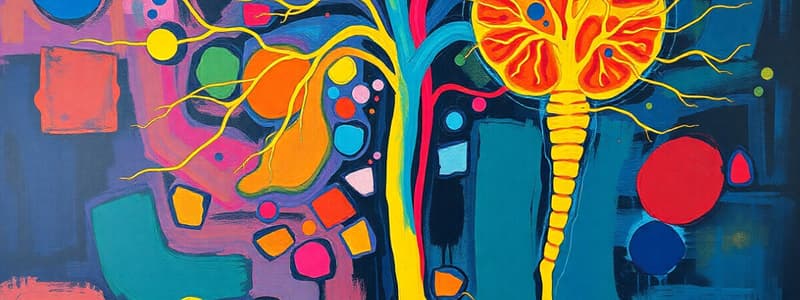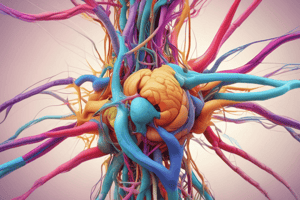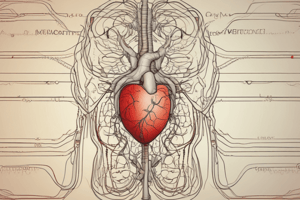Podcast
Questions and Answers
What does the autonomic nervous system control?
What does the autonomic nervous system control?
Autonomous functions, also known as visceral functions
Which division of the autonomic nervous system is also known as 'fight & fright'?
Which division of the autonomic nervous system is also known as 'fight & fright'?
- SNS (correct)
- ANS
- PSNS
What division of the autonomic nervous system is known as 'Rest & Digest'?
What division of the autonomic nervous system is known as 'Rest & Digest'?
Parasympathetic Nervous System (PSNS)
Match the Sympathetic and Parasympathetic effects on the following conditions:
Match the Sympathetic and Parasympathetic effects on the following conditions:
Which neurotransmitter is released by preganglionic neurons in both the sympathetic and parasympathetic nervous systems?
Which neurotransmitter is released by preganglionic neurons in both the sympathetic and parasympathetic nervous systems?
What type of receptor does Norepinephrine primarily bind to in the Sympathetic Nervous System?
What type of receptor does Norepinephrine primarily bind to in the Sympathetic Nervous System?
Epinephrine is released into the blood by the adrenal medulla.
Epinephrine is released into the blood by the adrenal medulla.
What enzyme degrades Acetylcholine?
What enzyme degrades Acetylcholine?
What is the rate limiting step in the synthesis of Acetylcholine?
What is the rate limiting step in the synthesis of Acetylcholine?
What happens after depolarization starts with the opening of sodium channels, during Acetylcholine production?
What happens after depolarization starts with the opening of sodium channels, during Acetylcholine production?
By what mechanism does Botulinum toxin inhibit the release of Acetylcholine?
By what mechanism does Botulinum toxin inhibit the release of Acetylcholine?
What is the most lethal toxin to mankind?
What is the most lethal toxin to mankind?
What action do Nicotinic (N) receptors perform?
What action do Nicotinic (N) receptors perform?
Muscarinic (M) receptors are iontropic receptors.
Muscarinic (M) receptors are iontropic receptors.
What type of action occurs following sodium entry into the muscle and depolarization
What type of action occurs following sodium entry into the muscle and depolarization
What is the function of M1 muscarinic receptors in the cerebral area?
What is the function of M1 muscarinic receptors in the cerebral area?
In the stomach, what effect does the M1 receptor have?
In the stomach, what effect does the M1 receptor have?
What is the effect of Acetylcholine in normal blood vessels?
What is the effect of Acetylcholine in normal blood vessels?
In damaged blood vessels, the M3 receptors on muscles contracts causing what?
In damaged blood vessels, the M3 receptors on muscles contracts causing what?
Flashcards
Autonomic Nervous System
Autonomic Nervous System
Controls autonomous functions also known as visceral functions
Sympathetic Nervous System
Sympathetic Nervous System
Functions in emergencies
Postsynaptic neurons
Postsynaptic neurons
Acetylcholine acts on these, containing nicotinic and muscarinic receptors.
Endogenous acetylcholine
Endogenous acetylcholine
Signup and view all the flashcards
Botulinum toxin
Botulinum toxin
Signup and view all the flashcards
Botulinum toxin
Botulinum toxin
Signup and view all the flashcards
Nicotinic receptor
Nicotinic receptor
Signup and view all the flashcards
Muscarinic receptors
Muscarinic receptors
Signup and view all the flashcards
Rest of the body
Rest of the body
Signup and view all the flashcards
Effect of Acetylcholine
Effect of Acetylcholine
Signup and view all the flashcards
Study Notes
- The autonomic nervous system (ANS) controls involuntary/visceral functions like heartbeat, blood pressure, and digestion.
Types of Nerves
- Preganglionic nerves are myelinated, while postganglionic nerves are non-myelinated.
Types of ANS
- The sympathetic nervous system (SNS) is associated with "fight or flight" responses.
- The parasympathetic nervous system (PSNS) is linked to "rest and digest" functions.
Sympathetic vs. Parasympathetic Effects
- SNS functions in emergencies while PSNS functions in relaxed conditions.
- SNS increases heart rate; PSNS decreases it.
- SNS dilates bronchi; PSNS constricts them.
- SNS dilates pupils (mydriasis); PSNS constricts them (miosis).
- SNS relaxes the bladder, reducing the urge to urinate; PSNS constricts the bladder, increasing urination.
- SNS reduces stomach acid secretion; PSNS increases it.
- SNS relaxes the intestine, PSNS frequent defecation
- SNS induces lipolysis; PSNS facilitates lipogenesis.
- SNS causes ejaculation; PSNS enables erection.
Relevant Anatomy
- SNS: Adrenergic, has thoracolumbar outflow (T1-L2) and small preganglionic nerves with long postganglionic nerves.
- PSNS: Cholinergic, has cranio-sacral outflow (cranial nerves 3, 7, 9, 10 and S1-S4) with long preganglionic nerves and short postganglionic nerves.
Neurotransmitters and Receptors
- Both SNS and PSNS use acetylcholine as the preganglionic neurotransmitter
- Postganglionic receptors are nicotinic neuronal receptors.
- SNS postganglionic neurotransmitters are norepinephrine, (primarily) and dopamine (minor, in kidney/GIT)
- PSNS postganglionic neurotransmitter is acetylcholine with muscarinic and nicotinic end organ receptors.
- SNS effects are produced by catecholamines (epinephrine, norepinephrine, dopamine)
- PSNS effects are produced only by acetylcholine.
- Some post-ganglionic nerves release acetylcholine, called sympathetic cholinergic nerves, innervating sweat glands and blood vessels and have muscarinic receptors.
Acetylcholine Physiology
- Acetylcholine is synthesized from Acetyl CoA inside the neuron.
- Choline uptake from surroundings is a rate-limiting step.
- After depolarization, acetylcholine enters vesicles and is released after depolarization.
- Acetylcholine acts on postsynaptic neurons containing nicotinic and muscarinic receptors.
- Acetylcholine esterase (ACHE) degrades acetylcholine and end organs.
- Choline is then reuptaken into the neuron.
Acetylcholine Degradation
- Endogenous acetylcholine in the synapse gets degraded by ACHE.
- Exogenous acetylcholine (from drugs) in blood plasma is degraded by butyrylcholinesterase (BChE) or pseudocholinesterase (PChE).
- Anticholinesterase drugs inhibit ACHE/PACHE, increasing acetylcholine levels and parasympathetic activity.
Cholinergic Toxins
- Drugs that block sodium entry are Saxitoxin and Tetrodotoxin.
- Drugs inhibiting entry into vesicle: Vesamicol.
- Drugs inhibiting choline uptake: Hemicholinium.
- Drugs blocking calcium channels: Botulinum toxin.
- Black widow spider venom causes massive release of ACh.
Botulinum Toxin
- Inhibit acetylcholine release by blocking calcium channels
- Calcium-dependent SNARE protein is the underlying issue
- Source: Clostridium botulinum, a bacterial toxin with types A-H
- Type A> B is effective for humans and Type A-BTX-A is used as a drug.
- Modify the drug by adding lipids
- Onabotulinum Toxin A, Abobotilinum Toxin A, or Incobotilinium Toxin A
- It is the most lethal toxin to mankind; 1 mg can kill 1 million people
- Injections must produce action at the local site only
- Respiratory Paralysis prevent cause of death respiratory paralysis
Botulinum Toxin Uses
- BATS: Relieve Muscle spasticity (rigidity)
- Blepharospasm
- Achalasia
- Torticollis/Wry neck
- Squint
- Relieve migraine pain.
- Treat hyperhidrosis
- Cosmetic Procedures - Botox
Receptors of Acetylcholine
- Nicotinic (N): Iontropic receptors which conduct sodium to cause an excitatory action, pentameric rosette shape.
- Muscarinic (M): G-protein coupled receptors (GPCRs), also known as metabotropic receptors, seven transmembrane, serpentine, helical shaped.
Nicotinic Receptor Details
- Nn: Neurons (Ganglionic receptors). SNS releases Epinephrine & Norepinephrine; PSNS releases Acetylcholine; Adrenal medulla (gland) releases Epinephrine. Agonist: Nicotine. Antagonist Ganglionic blockers (Hexamethonium, Mecamylamine, Trimethaphan).
- Nm: Skeletal muscles, muscle contraction occurs following sodium entry into the muscle and depolarization, part of the somatic nervous system, and voluntary actions. Subunits: α, β, γ, δ, ε. Agonist: Nicotine. Non-depolarizing muscle relaxants block (Tubocurare, Atracurium, Vecuronium).
Muscarinic Receptor Details
- 5 types (M1-M5).
- M1, M3, M5: Gq type GPCR (Excitatory), increases Calcium.
- M2, M4: Gi type GPCR (Inhibitory), decreases Calcium.
Location of Muscarinic Receptors
- CNS: Predominantly M1 receptors, including the hippocampus (increases memory/cognition, targeted for Alzheimer's treatment) and basal ganglia (decrease dopamine levels, use anticholinergics to increase levels in Parkinson's disease).
- Periphery: M1 in the stomach (increases HCl production, use Oxotremorine for research) and M2 in the heart (reduces heart rate, inhibits SA/AV node, uses Methacholine).
M3
- Excitatory
- Glands, smooth muscles for bronchoconstriction, Vasoconstriction
- Nitric oxide (EDRF), which is associated with vasodilation
What Happens During Ach Administration
- Normal Vessels: Acetylcholine produces Nitric oxide to relax muscles for vasodilation.
- Damaged vessels: Acetylcholine causes M3 receptors on muscles contracts causing vasoconstriction
Effect of Acetylcholine in body
- DUMBBELSS
- Increase all secretions in the body
- D: Diarrhea
- U: Urination
- M: Miosis
- B: Bronchospasm
- B: Bradycardia
- E: Excitation/Seizures
- L: Lacrimation
- S: Salivation
- S: Sweating
Studying That Suits You
Use AI to generate personalized quizzes and flashcards to suit your learning preferences.




